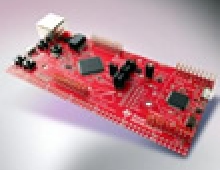
Texas Instruments' OMAP 5 Platform Takes Center Stage
Texas Instruments today turned the spotlight on the OMAP 5 platform, illustrating through live demonstrations the high performance capabilities of the addition to the OMAP processor family.
The 28nm platform is poised to service smartphones and numerous other markets-from automotive to smart home.
The OMAP5430 processor includes two ARM Cortex-A15 cores that provide the highest single-thread performance of any ARM CPU, TI claims.
Unique to the OMAP 5 smart multicore architecture is the use of two ARM Cortex-M4 cores to complement the two ARM Cortex-A15 cores. The M-class cores are assigned real-time control processing of multimedia tasks, like video encoding and decoding, freeing the main CPU cores to manage high level operating system tasks. In addition to minimizing the Cortex-A15 cores' interrupt rate, this off-loading function delivers a power savings-as much as 10 percent of the system power when encoding and decoding high definition H.264 content, for example.
The OMAP 5 platform represents several upgrades to preceding OMAP processor families, including the introduction of a second GPU. Through the use of dual-core PowerVR SGX544 GPUs from Imagination Technologies, the OMAP5430 processor outperforms the competition by up to 4x across common industry graphics benchmarks, according to TI. Imagination Technologies differentiates its SGX544 cores through the use of a tile-based deferred rendering architecture, which reduces bandwidth usage and minimizes power consumption when compared to competitive solutions. TI harnesses this graphics performance by complementing the GPUs with OMAP platform capabilities while running the cores at their maximum limit of 532Mhz.
The SGX544 cores are augmented by still another unique OMAP architecture feature-a dedicated 2D hardware-accelerated composition engine which can support up to 8 layers of high resolution composition without the need to go to external memory. The smart multicore system off-loads compositing to the composition engine, lowering power consumption by as much as 10x what the GPU would expend running the same eight layer composition process. This is done without passing data back to the memory, freeing the memory bandwidth for other multitasking functions.
Mobile platforms are constrained to a fixed thermal budget otherwise a device might feel too hot in a user's hand. If the processor exceeds this budget, it must be throttled. This is a process that can limit the real performance of the device.
"The OMAP 5 platform balances the right performance to deliver under this thermal constraint the highest possible effective MIPS, reaching upwards of 35 percent greater than the latest quad-core market solutions," TI said.
The OMAP 5 platform's image signal processor delivers fast capture of 16MP in 0.5s, 24MP at 30fps with zero shutter lag, and enhanced low-light performance. It also enables a device to use four simultaneous camera sensors for new end user applications. For example, users operating OMAP 5 processor-driven devices are also able to capture 1080p 60fps video while simultaneously taking 12MP still images. TI's advanced camera APIs will also support new features like night shot, advanced HDR and digital re-focusing, which allows users to focus an image even after the picture is taken.
During MWC 2012, booth visitors see the OMAP5430 processor showcasing some of its capabilities. These experiences will also leverage TI's WiLink 8.0 solution for Wi-Fi connectivity. The OMAP 5 platform in action demonstrates:
- A multi-layered, fluid 3D graphical user interface by SPB, leveraging graphics and composition engines
- A beautifully rendered game, with crisp graphics at full HD resolution
- Web/HTML5 acceleration for faster page loads, video playback, 3D transform and Web games
- Full-HD video playback through the wireless display connection to a 46-inch TV screen
The OMAP5430 processor includes two ARM Cortex-A15 cores that provide the highest single-thread performance of any ARM CPU, TI claims.
Unique to the OMAP 5 smart multicore architecture is the use of two ARM Cortex-M4 cores to complement the two ARM Cortex-A15 cores. The M-class cores are assigned real-time control processing of multimedia tasks, like video encoding and decoding, freeing the main CPU cores to manage high level operating system tasks. In addition to minimizing the Cortex-A15 cores' interrupt rate, this off-loading function delivers a power savings-as much as 10 percent of the system power when encoding and decoding high definition H.264 content, for example.
The OMAP 5 platform represents several upgrades to preceding OMAP processor families, including the introduction of a second GPU. Through the use of dual-core PowerVR SGX544 GPUs from Imagination Technologies, the OMAP5430 processor outperforms the competition by up to 4x across common industry graphics benchmarks, according to TI. Imagination Technologies differentiates its SGX544 cores through the use of a tile-based deferred rendering architecture, which reduces bandwidth usage and minimizes power consumption when compared to competitive solutions. TI harnesses this graphics performance by complementing the GPUs with OMAP platform capabilities while running the cores at their maximum limit of 532Mhz.
The SGX544 cores are augmented by still another unique OMAP architecture feature-a dedicated 2D hardware-accelerated composition engine which can support up to 8 layers of high resolution composition without the need to go to external memory. The smart multicore system off-loads compositing to the composition engine, lowering power consumption by as much as 10x what the GPU would expend running the same eight layer composition process. This is done without passing data back to the memory, freeing the memory bandwidth for other multitasking functions.
Mobile platforms are constrained to a fixed thermal budget otherwise a device might feel too hot in a user's hand. If the processor exceeds this budget, it must be throttled. This is a process that can limit the real performance of the device.
"The OMAP 5 platform balances the right performance to deliver under this thermal constraint the highest possible effective MIPS, reaching upwards of 35 percent greater than the latest quad-core market solutions," TI said.
The OMAP 5 platform's image signal processor delivers fast capture of 16MP in 0.5s, 24MP at 30fps with zero shutter lag, and enhanced low-light performance. It also enables a device to use four simultaneous camera sensors for new end user applications. For example, users operating OMAP 5 processor-driven devices are also able to capture 1080p 60fps video while simultaneously taking 12MP still images. TI's advanced camera APIs will also support new features like night shot, advanced HDR and digital re-focusing, which allows users to focus an image even after the picture is taken.
During MWC 2012, booth visitors see the OMAP5430 processor showcasing some of its capabilities. These experiences will also leverage TI's WiLink 8.0 solution for Wi-Fi connectivity. The OMAP 5 platform in action demonstrates:
- A multi-layered, fluid 3D graphical user interface by SPB, leveraging graphics and composition engines
- A beautifully rendered game, with crisp graphics at full HD resolution
- Web/HTML5 acceleration for faster page loads, video playback, 3D transform and Web games
- Full-HD video playback through the wireless display connection to a 46-inch TV screen




















